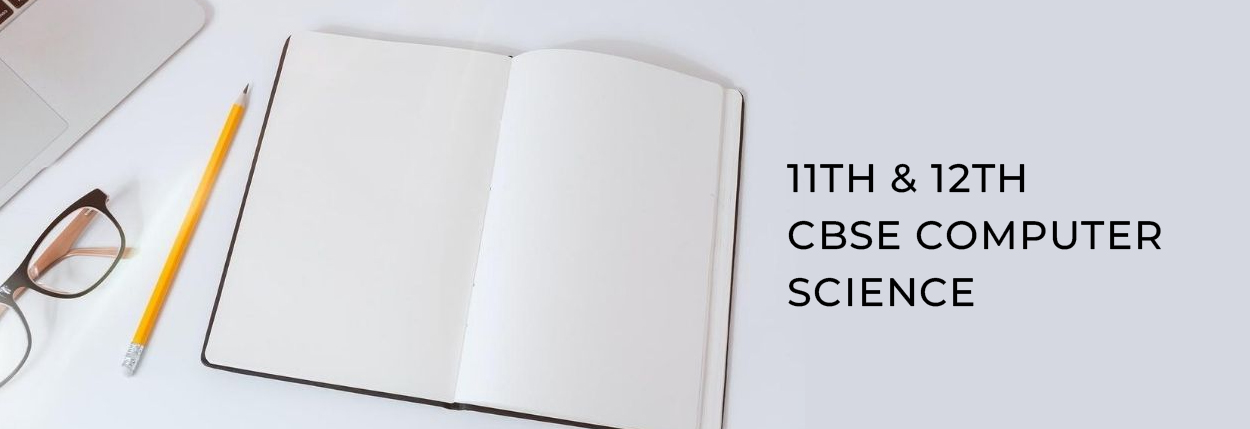Computer Science 11th Syllabus

Computer Fundamentals

Programming Methodology

Introduction to Python/C++

Programming with Python/C++

-
Operating System: Need for operating system, functions of operating system (processor management, memory management, file management and device management), types of operating system-interactive (GUI based), time sharing, real time and distributed, commonly used operating system: UNIX, LINUX, Windows, Solaris, BOSS (Bharat Operating System Solutions); Mobile OS - Android, Symbian.
Application Software: Office tools - word processor, presentation tool, spreadsheet package, database management system; domain specific tools - school management system, inventory management system, payroll system, financial accounting, hotel management, reservation system and weather forecasting system.

-
General Concepts: Clarity and simplicity of expressions, Use of proper names for identifiers, comments, indentation; documentation and program maintenance; running and debugging programs, syntax errors, run- time errors, logical errors
Problem solving methodologies: Understanding of the problem, solution for the problem, breaking down solution into simple steps (modular approach), identification of arithmetic and logical operations required for solution; control structure- conditional control and looping (finite and infinite).
Problem Solving: Introduction to algorithms/flowcharts.

-
Getting Started: Introduction to Python - an integrated high level language, interactive mode and script mode. Data types –Number (Integer - boolean, decimal, octal, hexadecimal; Floating point; Complex), none, Sequence (String,Tuples, List ) Sets, Mapping.
Variables, Expressions and Statements: Values, Variables and keywords; Operators and Operands in Python: (Arithmetic, relational and logical operators), operator precedence, Expressions and Statements (Assignment statement); Taking input (using raw_input() and input()) and displaying output (print statement); Putting Comments.

-
Getting Started: C++ character set, C++ Tokens (Identifiers, Keywords, Constants, Operators,), Structure of a C++ Program (include files, main function), Header files – iostream.h, iomanip.h, cout, cin; use of I/O operators (<<and>>), Use of endl and setw ( ), Cascading of I/O operators, compilation , Error Messages; Use of editor, basic commands of editor, compilation, linking and execution.
Introduction to user-defined function and its requirements. Defining a function; function prototype, Invoking/calling a function, passing arguments to function, specifying argument data types, default argument, constant argument, call by value, call by reference, returning values from a function, scope rules; local and global variables.
Computer Science 12th Syllabus
- Prerequisites
- Learning Outcomes
- Distribution of Marks
- Programming and Computational Thinking
- Practical
- Project
Computer Networks
- Structure of a network: Types of networks: local area and wide area (web and internet), new technologies such as cloud and IoT, public vs. private cloud, wired and wireless networks; concept of a client and server.
- Network devices such as a NIC, switch, hub, router, and access point.
- Network stack: amplitude and frequency modulation, collision in wireless networks, error checking, and the notion of a MAC address, main idea of routing. IP addresses: (v4 and v6), routing table, router, DNS, and web URLs, TCP: basic idea of retransmission, and rate modulation when there is congestion (analogy to a road network), Protocols: 2G, 3G, 4G, Wi- Fi. What makes a protocol have a higher bandwidth?
- Basic network tools: traceroute, ping, ipconfig, nslookup, whois, speed-test.
- Application layer: HTTP (basic idea), working of email, secure communication: encryption and certificates (HTTPS), network applications: remote desktop, remote login, HTTP, FTP, SCP, SSH, POP/IMAP, SMTP, VoIP, NFC.













